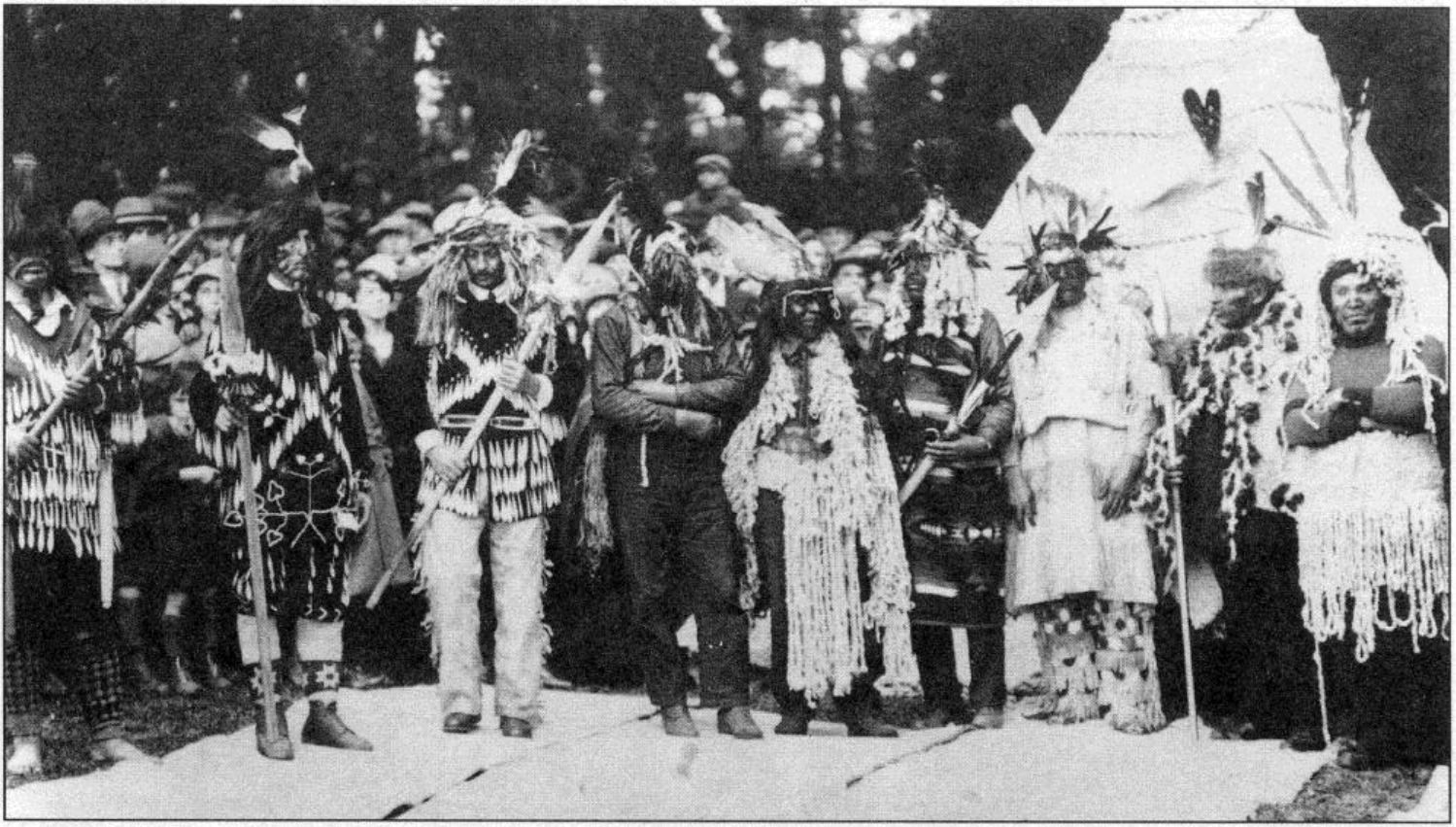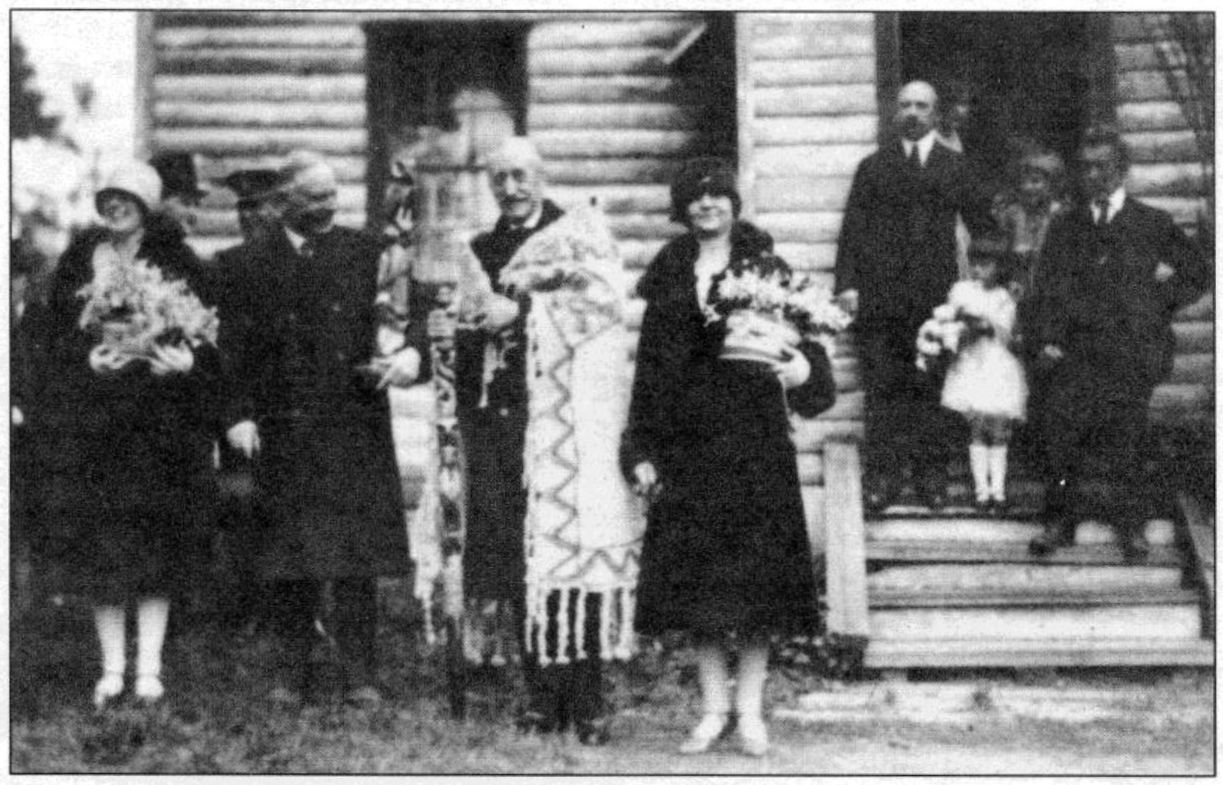Originally published in Discovery, 20(1).
Winter 1992.
By Grant Keddie
The Museum’s Anthropology photograph collection contains many photos whose subject and time remain a mystery. Recently, I put together a series of five undocumented photographs (four are shown in this article) from different parts of the collection that seemed to be related to the same event. A little detective work revealed that the photos documented the visit of the Governor-General of Canada to Victoria in 1927. As the highest ranking representative of the Crown, he was anointed as an honourary Indian chief. The information sources I located added to my knowledge of an earlier Indian history before the coming of Europeans … a history which I will reveal here in the context of the photographs.
In the century before the European settlement of Victoria, the Songhees people were under constant threat of war. The war raids came mostly from northern tribes such as the Yuculta and Comox from the Johnson Strait region. At these times, the Songhees retreated up The Gorge to Portage Inlet in the territory of one of their tribal groups called the Sahsum or Kosampson.
A stand was taken against their enemies at the spot now spanned by the Admirals Road bridge. Admirals Road cuts through the centre of the old village of the Sahsum. Part of the village was located in Craigflower Park where the old Craigflower School stands today, and part in the playgrounds of the new school to the east of Admirals Road.
By 1843 the Kosampson people moved to the village of Kala on Esquimalt Harbour, which became incorporated as part of the Esquimalt Indian reserve in 1853. In 1850, the Kosampson people were recognized by James Douglas, the Chief Factor of the Hudson’s Bay Company, as the owners of a territory that included most of the Esquimalt peninsula, The Gorge waters above Halkett Island, the east side of Esquimalt Harbour, Portage Inlet, and the Colquitz Creek drainage area, including Swan Lake and Christmas Hill.

To the north of the old Craigflower schoolhouse, where the change rooms are located today, was a special location for the installation of Sahsum chiefs. Here the people dug large quantities of soil from the sloping bank of the old village site, and created a large platform or amphitheatre. The soil was taken from this locality and put in a large mound that was used as a look-out station to watch for enemies. This mound is now buried beneath the south end of the new school grounds.
The successes in battle by the Sahsum at this location resulted in the earth platform being used as a place of celebration for warriors and for the creation of new chiefs. It was here that the representative of the British monarchy was also made an honourary chief.

The Ceremony of 1927
On 30 March 1927, the Songhees and other Salish chiefs from south-eastern Vancouver Island prepared a ceremony to name Canada’s Governor General, Viscount Willingdon, as a chief of the Sahsum tribe. The investiture took place at the amphitheatre. Newspapers of the time described the events: “Ceremonial dresses and symbols of authority among the tribesmen have fallen into disuse of late years and family cabinets are being searched and a general burnishing of ceremonial habiliments is taking place on the reserve in preparation for the coming event. Chief Cooper of the Songhees, who is acting as master of ceremonies, has ordered that not a single tribesman taking part shall appear in modem garb. There must be as striking a costume parade as the three main tribes concerned can muster. Chief David, of the Saanich tribe, who is approaching ninety years of age and whose memory goes back to the days when actual wars took place in the vicinity of the Gorge, will have the chief part in the Ceremonies.”
The latter quote is a bit of an exaggeration. David LaTasse, who was bom of a Songhees father and Saanich mother about 1849 on the Old Songhees reserve, would not have witnessed wars on The Gorge himself. Much of his information was probably passed down from his Songhees grandfather “Skull pult” who likely was a direct participant in the events of warfare. LaTasse spent most of his life on the Tsartlip and Brentwood Bay reserves in Saanich, but was knowledgeable in the rituals and ceremonies of both the Songhees and the Saanich peoples.
“One of the most spectacular parts of the ceremony will be the approach from Belleville Street to the scene. This will be made in war canoes. Three of these will carry the GovernorGeneral’s party and the Chiefs of the three tribes of the Songhees, Saanich and Malahats.” In the first canoe was the Governor-General and two aides. In the second was Lieutenant-Governor Robert W. Bruce, Helen Mackenzie, Colonel Brown and Aiderman Adam. In the third was Victoria Mayor J. Carl Pendray, Mrs Pendray and two aides. There were five native paddlers in the first three canoes, and eleven each in escorting war canoes.
“Led by Chief David (Saanich), Chief Alex (Malahat), and Chief Cooper (Songhees), war canoes will paddle the viceregal party on a tour of Inner Harbour scenes of historical association. Later, canoes will head up the Gorge waters, when the paddle chant sung by the tribesmen will be picked up and returned by Indians on shore at the point of reception at the Gorge Park…. The song of the paddle is a chant accompanied by the clicking of paddles against the gunwales of the canoes in time to the efforts of the paddlers, and in ringing chant, the words of which have been handed down from father to son in the tribes for centuries past. The braves who are to man the ceremonial canoes will be attired in full regalia and painted as were the warriors who set out on forays up and down the coast in the old days.”
Since the tide levels did not permit the party to proceed to the grounds of the ceremony, they disembarked just east of the Tillicum bridge and proceeded by car to visit Craigflower Manor and the amphitheatre.

The Installation
The elder chief, David LaTasse, ran the ceremony. According to LaTasse, the old ceremony of installing a chief involved his being struck on the forehead with a war club until blood was drawn. He was then declared chief. It was an honour that went only to outstanding leaders of the tribes, and carried with it powers of life and death for the reigning chief.
At the ceremony, “Chief David, speaking in his native tongue, described in graphic detail the bygone scenes, his words being interpreted by Chief Cooper”. While “crouched in the timber at the margin of the Gorge water, the braves stood ready to launch their canoes against the approaching enemy. Desperate battle took place in the swift flowing current of the Gorge, stated Chief David, the tactics of the Sahsums being to lure their opponents into the swift water, where their canoes could be easily upset by the local braves, who knew every foot of the way. After a victory, the amphitheatre was used as the scene of the triumph, where the tribe saluted the warriors, and hailed its chief. There new chiefs were created to fill the gap of war, or replace the warriors…” who had been killed.

The Governor-General was “touched with the war club to indicate the passage of tribal powers”. He was then presented with a wool blanket woven by native women, which was “presented to the new chief, with the headdress that accompanies the rank”.
He was given the name “Gottushun”, which was interpreted as “Chief Rainmaker, the Peacemaker”.
Chief Cooper presented the Governor-General with an “Indian walking stick” and the Lieutenant- Governor with a totem pole. “Chief Lazarre of the Sooke tribe presented Viscount Willingdon with a stone hammer, which had been handed down to him by his grandfather.” Indian baskets were given to “Her Excellency and Miss Mackenzie”. At the conclusion of the ceremony, the Governor-General presented Chief David with a Hudson’s Bay blanket.
